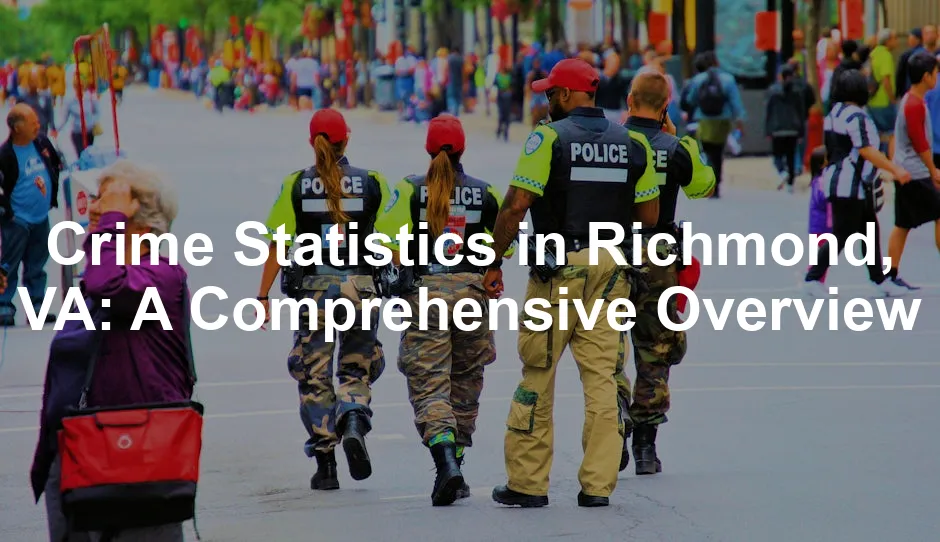Introduction
Richmond, Virginia, a city steeped in history, is known for its vibrant culture and picturesque streets. However, like every urban area, it faces the challenge of crime. Understanding crime statistics is crucial for residents and potential movers. These numbers provide insights into safety, trends, and the overall climate of the city. This article aims to offer a detailed overview of crime statistics in Richmond, covering trends, comparisons, and valuable insights. Whether you’re a long-time resident or considering a move, knowing the crime landscape can help you make informed decisions about living in this complex and dynamic city.

Understanding crime statistics can empower residents and help them make informed choices. statistics informed decisions using data
Understanding Crime Statistics
What Are Crime Statistics?
Crime statistics are numerical representations of criminal activities within a specific area. They help communities understand the safety of their neighborhoods. These statistics are vital for local authorities, residents, and policymakers. They provide a clear picture of crime trends and enable informed decisions regarding safety measures.
Crime can be categorized into two main types: violent crime and property crime. Violent crimes involve direct harm to individuals, including offenses like murder, assault, and robbery. Property crimes, on the other hand, involve theft or destruction of property without direct harm to a person. Examples include burglary, motor vehicle theft, and vandalism.
Understanding these distinctions is essential for grasping the broader implications of crime statistics. While violent crime often garners more media attention, property crime significantly impacts communities. High property crime rates can lead to a sense of insecurity, affecting residents’ quality of life.

If you’re looking to dive into the world of crime and its psychological implications, consider reading The Psychology of Crime and Criminal Justice by David M. McCarthy. This book delves into the motivations behind criminal behavior, providing valuable insights that can help communities understand and address crime more effectively.
By analyzing crime statistics, communities can identify patterns and trends. For instance, if a particular neighborhood sees a spike in burglaries, residents can take proactive measures. This might include forming neighborhood watch groups, increasing lighting in public spaces, or collaborating with local law enforcement.
Ultimately, crime statistics serve as a tool for empowerment. They give residents the information needed to advocate for safety measures in their communities. By staying informed about crime trends, residents can foster a sense of security and work towards creating safer neighborhoods for everyone.
How Crime Statistics Are Collected
Crime statistics are collected through various methods, primarily by law enforcement agencies. Two main systems are used in the United States: the FBI’s Uniform Crime Reporting (UCR) Program and the National Incident-Based Reporting System (NIBRS).
The UCR program has been around since the 1930s, providing a standardized method for law enforcement agencies to report crime data. It focuses on eight major crimes, known as Part I offenses, including violent crimes like murder and property crimes like burglary. However, the UCR primarily presents aggregate data, which means it does not capture the full complexity of crime incidents.
In contrast, NIBRS, which began replacing UCR in 2021, offers a more detailed approach. It collects data on over 50 different offenses, including attempts and victim-offender relationships. This granularity allows for a deeper understanding of crime trends and better informs community safety strategies.
Reliable data collection is crucial for understanding crime trends. Accurate statistics help law enforcement agencies allocate resources effectively and develop targeted crime prevention initiatives. When communities have access to comprehensive data, they can better evaluate their safety and advocate for necessary changes.

For Richmond, the integration of both UCR and NIBRS data provides valuable insights. By analyzing patterns in reported crimes, city officials can identify areas that need more attention, allowing them to implement targeted interventions. As a result, the city can prioritize resources and efforts to improve overall safety for its residents.
In summary, the collection of crime statistics is essential for fostering safer communities. By understanding the nuances of crime data, residents and authorities can work together to address safety concerns and create a more secure environment for all.
Crime Overview in Richmond, VA
General Crime Rates
Richmond, Virginia, presents a complex landscape regarding crime. With a crime rate of 38 per 1,000 residents, this city stands out as one of the higher crime spots in the United States. In fact, more than 95% of communities in Virginia boast lower crime rates than Richmond. The likelihood of becoming a victim of either violent or property crime here is approximately 1 in 27, which might make you think twice before heading out for a midnight snack.
When breaking down the numbers, Richmond’s violent crime rate is around 4 per 1,000 residents, which translates to a 1 in 273 chance of being a violent crime victim. In contrast, property crimes, which include theft and burglary, are significantly more prevalent, with a staggering rate of 34 per 1,000 residents. This means the chance of falling victim to property crime is about 1 in 29. You might want to keep a close eye on that bike left outside!

To put Richmond’s statistics in perspective, the national average for violent crime stands at about 4 per 1,000 residents, while property crime generally hovers around 20 per 1,000. So, while Richmond’s violent crime rate is comparable to the national average, its property crime rate is notably higher.
As you ponder the implications of these stats, consider armoring your home with a Home Security System with 24/7 Monitoring. It’s like having a personal bodyguard for your home, ready to alert you to any suspicious activity while you’re busy enjoying your midnight snacks!
In terms of total crime, Richmond reported 8,656 incidents last year, with 839 classified as violent crimes and a whopping 7,817 as property crimes. These figures highlight the need for vigilance among residents, especially in areas known for higher crime rates. Moreover, the city’s crime dynamics vary dramatically by neighborhood, indicating that some places are much safer than others.
As Richmond continues to implement community safety initiatives and law enforcement strategies, understanding these crime rates becomes crucial. Residents and potential movers alike should remain aware of the safety landscape. Awareness can lead to better decisions regarding where to live and how to stay safe.
Breakdown of Violent Crimes
Richmond’s violent crime statistics reveal a concerning picture. The types of violent crimes reported include murder, rape, robbery, and assault, each contributing to the overall safety perception in the city.
Murder rates in Richmond stood at 59 incidents last year, which translates to 0.26 murders per 1,000 residents. While any loss of life is tragic, this number reflects a significant issue that the city grapples with. Rape incidents were reported at 10, equating to a rate of 0.04 per 1,000 residents.
Robberies account for a more substantial portion of violent crimes, with 222 incidents reported, resulting in a rate of 0.97 per 1,000 residents. This statistic might make you think twice before walking alone at night, particularly in less populated or poorly lit areas.

Assaults dominate the violent crime category, with 548 incidents reported, leading to a rate of 2.39 per 1,000 residents. This data emphasizes the importance of community awareness and personal safety measures.
For those interested in the literary exploration of crime, consider picking up Crime and Punishment by Fyodor Dostoevsky. This classic novel delves into the psyche of crime and morality, offering a deep dive into the human condition that might just make you more aware of the world around you.
Richmond’s violent crime rate, while alarming, is not unique—similar urban areas face comparable challenges. Nonetheless, understanding the specific types of violent crimes helps residents and local authorities to implement targeted strategies. By knowing where these incidents occur, community members can work together to foster safer environments.
#### Violent Crime Statistics Table| Type of Crime | Number of Incidents | Rate per 1,000 Residents |
|---|---|---|
| Murder | 59 | 0.26 |
| Rape | 10 | 0.04 |
| Robbery | 222 | 0.97 |
| Assault | 548 | 2.39 |
| Total Violent Crimes | 839 | 3.66 |
This table summarizes the violent crime statistics, providing a clear snapshot of the challenges faced by the city. Understanding these figures helps residents grasp the safety landscape better and take precautions where necessary. As Richmond continues to address these issues, community engagement and awareness remain paramount.
Breakdown of Property Crimes
Property crimes are a significant concern in Richmond, Virginia. They encompass various offenses that involve the unlawful taking or destruction of someone else’s property. The primary types of property crimes include burglary, theft, and motor vehicle theft, each contributing to the city’s overall crime statistics.
Burglary typically involves breaking and entering into a building with the intent to commit a crime, usually theft. In Richmond, there were 786 reported burglaries last year, which equates to a rate of 3.43 per 1,000 residents. This indicates a relatively common occurrence, making it crucial for residents to secure their homes.

Theft, the most prevalent property crime in Richmond, accounted for a staggering 6,256 incidents, translating to a rate of 27.27 per 1,000 residents. This includes shoplifting, pickpocketing, and other forms of theft. The sheer volume of theft incidents suggests that residents should remain vigilant about their belongings in public spaces.
Motor vehicle theft is another noteworthy category, with 775 incidents reported, resulting in a rate of 3.38 per 1,000 residents. This statistic not only highlights the need for effective anti-theft measures but also underscores the importance of parking in well-lit, secure areas.
When examining trends, Richmond has seen fluctuations in property crime rates over the years. The property crime rate stands at 34.08 per 1,000 residents, significantly higher than the national average of around 20 per 1,000. This disparity raises concerns about safety and security among residents.
For added protection, consider investing in a Home Security Camera System. This handy gadget can help you keep an eye on your property, allowing you to relax while knowing you’re covered. Plus, you can record all those hilarious moments your dog has while you’re away!

The data reveals that certain neighborhoods experience higher rates of property crime. For example, areas like Gilpin Court and Hillside Court often report elevated theft and burglary incidents. Factors contributing to these higher rates may include socioeconomic challenges, lack of community resources, and a greater prevalence of transient populations.
To combat property crimes, local law enforcement implements various strategies, such as community watch programs and increased police presence in high-crime areas. Residents are encouraged to take proactive measures, such as securing their homes and vehicles, to mitigate the risk of becoming victims.
In summary, the landscape of property crimes in Richmond showcases the need for heightened awareness and community involvement. By understanding the types of property crimes and their prevalence, residents can better protect themselves and contribute to a safer environment for all.
#### Property Crime Statistics Table| Type of Crime | Number of Incidents | Rate per 1,000 Residents |
|---|---|---|
| Burglary | 786 | 3.43 |
| Theft | 6,256 | 27.27 |
| Motor Vehicle Theft | 775 | 3.38 |
| Total Property Crimes | 7,817 | 34.08 |
This table succinctly summarizes property crime statistics, offering a clear snapshot of the challenges faced by Richmond’s residents. Understanding these figures is essential for fostering community awareness and safety initiatives. With continued efforts from both law enforcement and residents, Richmond can work towards reducing these statistics and improving the overall safety of the city.
Trends and Comparisons
Yearly Crime Trends
Richmond’s crime landscape has seen its fair share of ups and downs over recent years. Analyzing the data reveals significant shifts in both violent and property crime rates. For instance, the total crime rate in Richmond stands at 38 per 1,000 residents, placing it among the higher echelons of urban crime rates in the United States. Interestingly, this figure has remained relatively stable over the past few years, with only minor fluctuations.

When we look closer at violent crimes, the rate hovers around 4 per 1,000 residents. However, the number of violent crimes reported last year was 839, a notable increase from previous years. This uptick has raised eyebrows, prompting discussions about community safety and the effectiveness of law enforcement strategies.
On the other hand, property crimes tell a different story. With a staggering 34 per 1,000 residents, property crime rates have consistently outweighed violent crime rates. In fact, property crime incidents amounted to 7,817 last year, indicating that residents should be particularly vigilant about theft and burglary. This number has slightly decreased compared to previous years, suggesting that certain preventative measures might be taking effect.
As you navigate the complexities of crime in Richmond, consider equipping yourself with a Smart Lock for Front Door. Not only does it provide enhanced security, but it also gives you the convenience of keyless entry. Imagine never having to fumble for your keys again while juggling groceries!
A deeper dive into specific categories of crime reveals interesting trends. For example, robbery has seen a slight increase, with 222 incidents reported last year. Meanwhile, assault figures have also risen, accounting for 548 incidents. These trends signal a need for increased community awareness and proactive safety measures.
Moreover, comparing year-over-year data shows that while some years have experienced spikes in criminal activity, Richmond has not seen any dramatic surges. This relative stability is a bit of good news amidst the concerns surrounding the city’s crime statistics.
Overall, these yearly trends highlight the complexities of crime in Richmond. While the city grapples with its challenges, the community and local authorities are continuously adapting strategies to enhance safety and security for residents. Keeping an eye on these trends will be crucial for anyone considering moving to or living in Richmond.
Richmond vs. Other Cities
When comparing Richmond’s crime statistics to other similar-sized cities, the results are eye-opening. Cities like Pittsburgh and Charleston provide a useful benchmark for understanding Richmond’s standing in the crime hierarchy.
Richmond’s violent crime rate of approximately 3.66 per 1,000 residents is comparable to the national median of 4. However, it’s on the higher side when placed next to Pittsburgh, which boasts a lower violent crime rate. In Pittsburgh, this figure sits around 3.2, indicating that Richmond struggles a bit more with violent offenses.

Conversely, when we turn our attention to property crimes, Richmond’s statistics stand out dramatically. The property crime rate in Richmond is around 34.08 per 1,000 residents, significantly higher than Charleston’s rate of approximately 20 per 1,000. This stark difference suggests that residents in Richmond face a greater risk of property crimes, such as theft and burglary, compared to their neighbors in Charleston.
Moreover, Richmond’s total crime incidents, which tallied 8,656 last year, place it above many cities of similar size. For example, while both Richmond and Pittsburgh are comparable in population, Pittsburgh reported fewer total crime incidents, showcasing a more favorable safety perception.
For those who enjoy a good crime drama, consider watching The Wire: The Complete Series. This critically acclaimed show dives deep into the complexities of crime and law enforcement in Baltimore, offering insights that resonate with urban living.
It’s important to note that crime trends within cities can vary significantly depending on community engagement and law enforcement strategies. Richmond has made strides in addressing crime through community initiatives, yet it still faces challenges that set it apart from cities like Charleston and Pittsburgh.
Overall, the comparisons reveal a mixed picture. Richmond has its challenges with crime, particularly in property offenses. However, understanding these statistics in context helps residents and potential movers grasp the safety landscape. By staying informed, the community can work together to foster a safer Richmond, making it a welcoming place for all.
Law Enforcement and Community Initiatives
Role of the Richmond Police Department
The Richmond Police Department (RPD) plays a pivotal role in addressing crime in the city. Their ongoing efforts to reduce crime involve a blend of traditional policing strategies and community engagement initiatives. The department focuses on building trust with residents while tackling crime head-on.
One of the key strategies employed by the RPD is community policing. This approach encourages officers to develop relationships with community members, fostering open lines of communication. Through these interactions, residents feel more comfortable reporting crimes and suspicious activities, creating a more proactive crime prevention environment.
Additionally, the RPD hosts community meetings and safety workshops, educating residents on crime trends and personal safety tips. These initiatives help empower citizens to take an active role in their neighborhood’s safety. The department also collaborates with local organizations to provide resources and support for residents, particularly in high-crime areas.

Another noteworthy program is the Neighborhood Watch initiative. This grassroots effort encourages residents to keep an eye on their surroundings and report any suspicious behavior. By involving the community, the RPD enhances its crime-fighting capabilities while also promoting a sense of ownership and responsibility among residents.
Moreover, the department continuously analyzes crime data to identify hotspots and allocate resources effectively. By understanding where crime is most prevalent, officers can focus their patrols and community outreach efforts accordingly.
In summary, the Richmond Police Department’s dedication to community engagement and proactive crime prevention is vital in shaping the city’s safety landscape. By working together, law enforcement and residents can create a safer, more secure Richmond for everyone.
Community Engagement and Safety Initiatives
Richmond, VA, is bustling with community-driven initiatives aimed at enhancing safety. Residents are not just passive observers but active participants in making their neighborhoods safer. One prominent program is the Neighborhood Watch. This initiative encourages residents to keep an eye on their surroundings and report suspicious activity to law enforcement. When neighbors look out for one another, crime can take a back seat!
Another handy tool for residents is safety apps. For instance, the “Nextdoor” app fosters communication among neighbors. Users can share local alerts, community events, and safety tips. It’s like having a neighborhood watch in your pocket! And don’t forget about the Richmond Police Department’s regular community meetings, where residents can voice concerns and learn about crime trends.
The Richmond Police Department (RPD) also offers resources for residents to stay informed. Their website features crime statistics and safety tips tailored to specific neighborhoods. Local crime maps allow residents to visualize crime hotspots, helping them to stay vigilant. This transparency helps build trust and encourages community involvement in safety initiatives.

For those looking to get more involved, the RPD has various volunteer opportunities. Programs like the Citizens Police Academy educate residents about police work and foster partnerships between officers and the community. Engaging in these programs not only enhances personal safety but also strengthens community bonds.
Moreover, Richmond actively promotes partnerships with local organizations. These collaborations focus on youth engagement, education, and crime prevention. Initiatives like mentorship programs guide young people toward positive life choices, steering them away from potential criminal activities.
In summary, Richmond’s community engagement and safety initiatives empower residents to take charge of their safety. Through neighborhood watch programs, safety apps, and collaborative efforts with local organizations, the city fosters a proactive approach to crime prevention. When the community and law enforcement work hand-in-hand, a safer Richmond emerges for everyone.
Conclusion
Understanding crime statistics is vital for residents and potential movers in Richmond, VA. The city’s crime landscape can be daunting, with a crime rate of 38 per 1,000 residents. However, it’s essential to remember that these numbers don’t tell the whole story. Richmond has many neighborhoods where safety thrives, thanks to community engagement and proactive law enforcement efforts.
Key takeaways include the importance of being informed about crime trends and the resources available, such as neighborhood watch programs and safety apps. Engaging in community initiatives can significantly enhance personal safety and foster a sense of belonging.
For those interested in personal safety, consider picking up Safety First: The Essential Guide to Personal Safety. This book equips you with essential tips and tricks to stay safe in various situations, making sure you’re prepared for anything life throws your way!
Ultimately, knowledge is power. By understanding crime statistics, residents can make informed decisions about their safety and the best neighborhoods to call home. Richmond may have its challenges, but with awareness and community involvement, a safer and more secure environment is within reach for everyone.
FAQs
What are the crime rates in Richmond, VA?
Richmond has a crime rate of approximately 38 per 1,000 residents, with violent crime at 4 per 1,000 and property crime at 34 per 1,000.
How does Richmond compare to other cities in Virginia?
Richmond’s crime rates are higher than most Virginia communities, with over 95% of them reporting lower rates.
What should I do if I become a victim of crime in Richmond?
Report the incident to the Richmond Police Department immediately. Use the non-emergency number at (804) 646-5100 for assistance.
Are there safe areas to live in Richmond?
Yes, neighborhoods like Windsor Farms, Woodland Heights, and The Fan are known for their safety and low crime rates.
Please let us know what you think about our content by leaving a comment down below!
Thank you for reading till here 🙂
All images from Pexels




